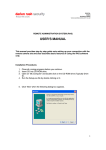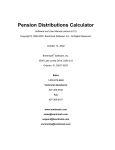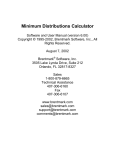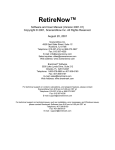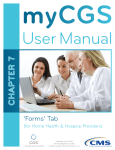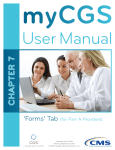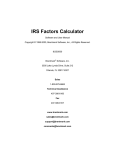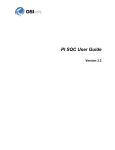Download Pension Distributions Planner
Transcript
Pension Distributions Planner Software and User Manual (version 8.00) Copyright © 1995 - 2005, Brentmark Software, Inc., All Rights Reserved. December 7, 2005 Brentmark® Software, Inc. 3505 Lake Lynda Drive, Suite 212 Orlando, FL 32817-8327 Sales 1-800-879-6665 Technical Assistance 407-306-6160 Fax 407-306-6107 www.brentmark.com [email protected] [email protected] Table of Contents Table of Contents Chapter 1 ..............................................................................................1 Introducing the Program ..................................................................................................... 1 Welcome to the Pension Distributions Planner............................................................... 1 Installation....................................................................................................................... 1 Installing the Program.............................................................................................. 1 Uninstalling the Program ......................................................................................... 2 What Do I See on the Screen? ......................................................................................... 2 Title Bar ....................................................................................................................... 2 Menu Bar ..................................................................................................................... 2 Toolbar......................................................................................................................... 3 Data Entry Section....................................................................................................... 3 Command Buttons ....................................................................................................... 3 Display Area ................................................................................................................ 3 Hint Line ...................................................................................................................... 3 Shortcut Keys .................................................................................................................. 3 Chapter 2 ..............................................................................................5 Working with Files .............................................................................................................. 5 Frequently Used Procedures............................................................................................ 5 Create a New File..................................................................................................... 5 Open an Existing File............................................................................................... 5 Reopen File .............................................................................................................. 5 Save a File ................................................................................................................ 5 Copy an Existing File (Save As).............................................................................. 5 Access the Print Report Window............................................................................. 6 Set up a Printer ......................................................................................................... 6 Exit the Program ...................................................................................................... 6 Take Distributions at the End of the Year................................................................ 6 View the Program in 16 Colors ............................................................................... 6 Chapter 3 ..............................................................................................7 Calculating Minimum Distributions .................................................................................... 7 Minimum Distributions ................................................................................................... 7 Stretch IRAs .................................................................................................................... 8 Inherited IRAs................................................................................................................. 9 Beneficiary...................................................................................................................... 9 Type of Plan.................................................................................................................. 10 Pension Distributions Planner Chapter 4 ........................................................................................... 13 Including Dates of Death and Spousal Rollovers ................................................................ 13 Multiple Beneficiaries and Separate Accounts Rule ..................................................... 13 Chapter 5 ........................................................................................... 15 Calculating Pre -59½ Distributions ..................................................................................... 15 Pre-59½ Distributions Calculator.................................................................................. 15 Reasonable Interest Rate ............................................................................................... 18 Chapter 6 ........................................................................................... 19 Including Contributions & Additional Distributions ......................................................... 19 Contributions ................................................................................................................. 19 Distributions .................................................................................................................. 19 Chapter 7 ........................................................................................... 21 Viewing Results ................................................................................................................. 21 Reports .......................................................................................................................... 21 Chapter 8 ........................................................................................... 23 Printing Reports & Graphs................................................................................................ 23 Print Report Window .................................................................................................... 23 Chapter 9 ........................................................................................... 25 Formatting Reports ........................................................................................................... 25 Report Options Window................................................................................................ 25 Create a Heading for a Report................................................................................ 25 Page Margin ........................................................................................................... 25 Change Fonts.......................................................................................................... 25 Other Printing Options NT.................................................................................... 25 Chapter 10......................................................................................... 27 Getting Help ...................................................................................................................... 27 Help Menu..................................................................................................................... 27 Help System .................................................................................................................. 27 Technical Support ......................................................................................................... 27 Table of Contents Chapter 11......................................................................................... 29 Reference Material ............................................................................................................ 29 Minimum Distributions Calculations ............................................................................ 29 Rev. Rul. 2002-62; 2002-42 IRB 1 (3 Oct 2002).......................................................... 32 Discussion of Revenue Ruling 2002-62........................................................................ 36 IRS Notice 89-25........................................................................................................... 38 Minimum Distribution Incidental Benefit (MDIB) (Only applicable before 2002) ..... 40 Calculating Required Minimum Distributions using the 2001 Proposed Regulations: 41 1987 Proposed Regulations (Pre-2001 Rules) .............................................................. 43 Mortality Table.............................................................................................................. 44 License Agreement............................................................................................................. 45 Index.................................................................................................................................. 46 iii Introducing the Program Chapter 1 Introducing the Program Welcome to the Pension Distributions Planner Brentmark offers four different programs in the area of planning for distributions from qualified retirement plans: Pension Distributions Planner, Pension Distributions Calculator, Minimum Distributions Calculator, and the Pension & Roth IRA Analyzer. All the programs illustrate minimum distributions both during lifetime and after death, including those for Stretch IRAs, Rollovers, Inherited IRAs, Roth IRAs, and Roth 401(k)s. They also let you illustrate the effects of continuing to make contributions and of distributing more than the minimum required amount. The Pension Distributions Planner, Pension Distributions Calculator, and Pension & Roth IRA Analyzer also illustrate the substantially equal periodic payments needed to make pre-59½ distributions (also known as section 72(t) distributions) without incurring the 10% penalty. The Pension Distributions Planner and Pension & Roth IRA Analyzer also lets you illustrate distributions to multiple beneficiaries. They handle the separate accounts rule and the case where distributions are governed by the oldest beneficiary. The Pension & Roth IRA Analyzer goes far beyond the other products – including income and estate taxes, gifting, insurance, Roth conversions, and much more. It is beyond the scope of this manual. In addition to this manual, the software comes with a comprehensive help system that includes relevant revenue rulings, IRS Notices, private letter rulings, and expert analysis of key calculation areas. Installation Getting started with the software is easy. Before you install the program, be sure that you’re running a Windows 95 or later operating system. The software does not run on Windows 3.1 or earlier operating systems. Installing the Program Insert the disk into the disk drive. 1 Pension Distributions Planner If the installation program doesn’t start automatically, then click the Start button on the Windows taskbar. On the Start menu, click Run. The Run dialog box appears. In the Open box, type “D:\setup.exe” (replacing “D” with the drive letter of your CD drive). Click OK. The setup program begins. Follow the instructions in the setup program. Uninstalling the Program Run the Windows Control Panel (located on the Start Menu) and click Add/Remove Programs . Use the scrollbar to find the program. When you find it, click the program title. Notice that the Add/Remove button is now functional. Click the Add/Remove button. The uninstall program begins. Follow the instruction in the uninstall program. What Do I See on the Screen? When you run the program, the main window opens. Following are brief descriptions of what you see. Title Bar The title bar appears in the top of the window. It contains the following information: • Program Title • Program version number • File name (if a file has been loaded) Menu Bar The Menu bar is below the title bar. The Menu bar contains three menus that you use to make program commands. 2 Chapter 1: Introducing the Program Toolbar The toolbar is below the menu bar. The toolbar contains graphics that you click to execute frequently used program commands. You can use these graphics instead of using the related Menu bar commands. Open Files. Save Files. Brentmark Online. Print Files. Get Help. Data Entry Section A data entry section appears in the left side of the window. Use this section to enter the information needed for the calculations. Command Buttons Two command buttons appear below the data entry section. Use these to enter additional distributions and contributions. Display Area The right side of the window is the display area. Here, you can view graphs or reports that display the results of the calculations. Hint Line The Hint Line displays short commands to help you with data entry. As you move the pointer across buttons, input boxes, and other areas of the window, the Hint Line displays different commands. Shortcut Keys Use the function keys for frequently used commands: F1 Access the Help system. F2 Save files. 3 Pension Distributions Planner F3 Open files. F6 Print reports. F7 Create a new file. 4 Working with Files Chapter 2 Working with Files Frequently Used Procedures Refer to this chapter to view instructions for procedures that you’ll frequently use when working with files. Create a New File On the File menu, click New. The program clears all previous data entry and resets the program’s default va lues. Open an Existing File 1. On the File menu click Open. Or on the toolbar, click the Open graphic. The Open dialog box appears. You can also select Reopen File to quickly reopen a file you’ve been working with. 2. In the File name box, enter the name of the file and the proper extension. Be sure you have selected the proper drive and folder that contain your file. Reopen File On the File menu, click Reopen File. A list of files you’ve worked on recently will appear. Select the name of the file you wish to reopen. Save a File 1. On the File menu, click Save. Or on the toolbar, click the Save graphic. 2. If the file has not been saved previously, the Save As dialog box appears. 3. Select the drive and folder in which to save the file. 4. In the File name box, type a name for the file. The program automatically adds .PDC extension to the file name. Copy an Existing File (Save As) 1. Open an existing file or create a new file. 5 Pension Distributions Planner 2. On the File menu, click Save As. Or on the toolbar, click the Save graphic. The Save As dialog box appears. 3. Select the drive and folder in which you want to save the file. 4. In the File name box, enter a name for the new file. The program automatically adds the proper extension to the file name. Access the Print Report Window On the File menu, click Print. Set up a Printer On the File menu, click Print Setup. The Print Setup dialog box appears. For help with setting up a printer, click in the Print Setup dialog box. Exit the Program On the File menu, click Exit. If you haven’t saved your data, you will be given a chance to do so. Take Distributions at the End of the Year By default, all fund activity takes place at the beginning of the year. This includes required minimum distributions and any additional distributions. If you prefer, you can have all fund distributions occur at the end of the year. On the Options menu, click Take Distributions at End of Year. View the Program in 16 Colors Though rarely necessary on today’s modern displays, if yo u would like to view the colors in 16 colors, click 16 Color Display. On the Options menu. 6 Calculating Minimum Distributions Chapter 3 Calculating Minimum Distributions Minimum Distributions To calculate required minimum distributions, enter data on the main screen. Most of these inputs are very straightforward, but here is a description of each one in case you have any questions. Note: By default, all fund activity takes place at the beginning of the year. This includes distributions and contributions. To have activity occur at the end of the year, click Take Distributions at End of Year on the Options menu. Minimum Distributions Calculation: Table of Inputs Input Description First Year of Analysis Enter the first year of the analysis. Type of Plan Select the type of qualified plan. For details on the types of plans that the program considers qualified, see the section later in this chapter. Year of First Required Distrib. If the Type of Plan is Normal, the program enters the Year of First Required Distrib. If the plan is a <5% Owner plan, enter the date of your client’s first required distribution in the Retirement box. 12/31/(previous year) Balance Enter the value of all assets in the plan as of the end of the previous year. Expected Plan Growth Enter the expected annual percent increase of the plan. Is there a Designated Beneficiary? Select whether there is a designated beneficiary by clicking yes or no. 7 Pension Distributions Planner Owner’s Birth Date Enter the plan Owner’s Birth Date in month/day/year format. If an owner’s birth date is before 1917, the program displays a warning in the Hint Line . The minimum distributions rules for owners with birth dates prior to 1917 are more complex and may be different than the current rules. Therefore the program bases its calculations on minimum distributions rules after 1917 (see Proposed Treas. Reg. Sec.1.408-8 for IRAs and 1.401(a)(9) for Qualified Plans). Beneficiary’s Birth Date Enter the Beneficiary’s Birth Date in month/day/year format. The program uses the beneficiary’s birth date to determine joint life expectancy factors as well as a single life expectancy for the beneficiary. See the expanded discussion below of beneficiaries. Minimum Distributions Options For distributions prior to 2001, additional calculation options were available. For more details about Minimum Distributions options, see Chapter 11, Reference Material. Assume Death Occurs Click Assume Death Occurs and the Benef Info button to enter Assumed Dates of Death, Spousal Rollover, and multiple beneficiary information. Use this checkbox for Stretch IRAs, Inherited IRAs, spousal rollovers, Roth IRAs, and multiple beneficiaries. The two most common questions we receive about the software are how to illustrate a Stretch IRA and how to illustrate an Inherited IRA. Handling both cases is really quite easy. Stretch IRAs The very popular "Stretch IRA" illustration simply illustrates the benefits to the heirs of proper planning. By making the proper beneficiary designation, your client can ensure that his or her heirs receive lasting value from the IRA. To show this in the software: 1. Check the Assume Death Occurs checkbox at the bottom of the inputs. If you are illustrating a Roth IRA, this checkbox does not appear because it is assumed to be checked. 8 Chapter 3: Calculating Minimum Distributions 2. Click the Benef. Info button to indicate when the owner and/or beneficiary die, and if there are multiple beneficiaries named. Inherited IRAs Inherited IRAs are those where the original owner has already passed away. In some cases, the original owner’s birth date is relevant to the calculation. Therefore, the program needs you to enter this information. To enter an Inherited IRA: 1. Enter the birth date of the original owner (the one that has passed away) as the Owner’s Birth Date on the main input screen. Enter the surviving beneficiary’s birth date as the Beneficiary’s Birth Date. 2. Check the Assume Death Occurs checkbox at the bottom of the inputs. If you are illustrating a Roth IRA, this checkbox does not appear because it is assumed to be checked. 3. Click the Benef. Info button to indicate when the owner and/or beneficiary die, and if there are multiple beneficiaries named. For the Owner’s Death, uncheck the "Calculate" checkbox and enter the year the owner actually died. It is okay to enter a year of death prior to the current year. Note: If your client is a surviving spouse and has rolled the IRA into his/her own IRA, there is no need to enter the original owner. You can treat the surviving spouse as the owner of the plan. Beneficiary Under the final minimum distributions regulations, the specification of a beneficiary appears to be irrelevant. It is not. Always enter the actual beneficiary’s birth date, and indicate if the beneficiary is the spouse or not. Generally, the term beneficiary refers to an individual. If a charity or the plan owner’s estate is named as the beneficiary, there is no “designated beneficiary,” and you should answer “No” to the question Is there a Designated Beneficiary?. A trust can also be named as the beneficiary. In such cases, there is often a “passthrough” person, whose birth date should be entered as the Beneficiary’s birth date. Note that trusts are generally not considered to be spouses. If the trust does not meet the following rules, then there is no “pass-through” person: • Trusts must be valid under state law (or would be valid under state law if it had a trust corpus). 9 Pension Distributions Planner • Trusts must be irrevocable as of the participant’s death. • Trusts must benefit an individual or a specified class of individuals so that the life expectancy can be determined. • Trusts must be copied, and a copy must be given to the plan administrator by the required beginning date. Type of Plan The program calculates required minimum distributions for the following types of pension plans: • Corporate and self-employed pension, profit sharing and stock bonus plans qualified under IRC Sec. 401(a) (includes Keogh or H.R. 10 plans, 401(k) plans, and employee stock ownership plans or ESOPs), • Individual Retirement Accounts (IRAs) under IRC Sec. 408(a), • Simplified Employee Plans (SEPs) under IRC Sec. 408(k), and • Tax-sheltered annuities (except for account balances existing on 12/31/86 if kept separate for accounting purposes) under IRC Sec. 403(b). The Pension Distributions Planner classifies retirement plans into three groups. When calculating minimum distributions, you need to select a Type of Plan. Following are descriptions of the choices that the program provides. Normal This is the most common selection if the plan owner is retiring on or before age 70½, and the plan is not a Roth IRA. Use it for IRAs, 401(k)s, and Roth 401(k)s that are not rolled into Roth IRAs. Roth IRA The Roth IRA was created by the Taxpayer Relief Act of 1997. There are no required distributions until the year after the plan owner dies. The required beginning date of minimum distributions from a Roth IRA is the year after the owner’s death. At that point, the minimum distributions are calculated based on the beneficiary's single life expectancy. If the beneficiary is the Roth IRA owner’s spouse, the election to recalculate the beneficiary's single life expectancy each year after the required beginning date is available. For nonspousal beneficiaries, the life expectancy is calculated once and reduced by one for each year after the required beginning date. 10 Chapter 3: Calculating Minimum Distributions Use this selection also for Roth 401(k)s if you are planning on rolling them to Roth IRAs when the owner retires. <5% Owner Use this selection if the owner is planning to retire after age 70½ and owns no more than 5% of a company with a plan that is not an IRA. If the plan owner owns no more than 5% of a company with a pension plan that is not an IRA, the required minimum distributions are delayed until the retirement year. 11 Dates of Death and Spousal Rollovers Chapter 4 Including Dates of Death and Spousal Rollovers Use the Beneficiary Info dialog box to handle the death of either the plan owner, the beneficiary, or both. Also, for cases in which the plan owner dies, you can indicate when a spousal rollover will occur. To enter dates of death and spousal rollovers, check the Assume Death Occurs check box and the Benef. Info button in the Main window. For Roth IRAs, the Assume Death Occurs checkbox is checked automatically (and hidden). In that case, just click the Beneficiary Info button. The Beneficiary Information window asks you a series of simple questions: Assume Owner Dies? Assume Beneficiary Dies? Assume Spouse Rollover? Does the Spouse Name a Beneficiary? The software only asks you those questions which are relevant to your case. For example, if the beneficiary is not the spouse, it won’t ask you if there’s a spousal rollover. There is a checkbox next to each year input field on this window. Check the box to have the software calculate the year. Uncheck it to enter in your own year. Multiple Beneficiaries and Separate Accounts Rule You may not use separate life expectancies for multiple beneficiaries unless all of the beneficiaries are individuals and you have satisfied the separate accounts rule. If all of the beneficiaries are individuals, but the separate accounts rule has NOT been met, all of the beneficiaries must use the oldest beneficiary's life expectancy for required minimum distributions. Under the regulations, a separate account “is a portion of an employee’s benefit determined by an acceptable separate accounting including allocating investment gains and losses, and contribut ions and forfeitures, on a pro rata basis in a reasonable and consistent manner between such portion and any other benefits.” If the plan is being split between multiple beneficiaries at death, enter their names, what percentage of the plan each receives, and their birth years. 13 Pension Distributions Planner The program allows you to illustrate multiple beneficiaries both using the Separate Accounts Rule and not using the Separate Accounts Rule. Check the box labeled "Apply Separate Accounts Rule" to assume the Separate Accounts Rule is satisfied in the year after the death of the plan owner. Check the box labeled "Delay Separate Accounts 1 Year" to assume that the Separate Accounts Rule is satisfied, but not in time for the calculation of distributions in the year after death. Checking this box causes the distributions in the year after death to be based on the life expectancy of the oldest beneficiary. All subsequent years use the Separate Accounts Rule. The Delay Separate Accounts Rule is not relevant after 2004 – so the choice is not given if the year of death is after 2004. Note: Entering Multiple Beneficiaries is only possible in the Pension Distributions Planner. 14 Chapter 5: Calculating Pre-59½ Distributions Chapter 5 Calculating Pre-59½ Distributions Pre-59½ Distributions Calculator Note: Pre-59½ Distributions are only handled by the Pension Distributions Calculator and Pension Distributions Planner. Use the Pre-59½ Distributions Calculator to calculate the “substantially equal periodic payments” that plan owners need to make in order to avoid the 10% penalty for early distributions. To access the Pre-59 ½ Distributions Calculator, click Pre-59½ on the toolbar. The Pre59½ distributions screen shows only those inputs that are relevant to the current case. If the input is irrelevant to the case, the input field will disappear. Enter information in order (from top to bottom). If you would like to illustrate the Pre-59½ distributions as part of an overall illustration (along with the minimum distributions), check the box “Use Pre-59½ Distributions” at the bottom of the screen. The pre-59½ distributions will be included in the summary of distributions report. It’s important to realize, however, that the summary of distributions report assumes all distributions happen annually – so the projected balances may differ from those on the pre-59½ distributions screen. Note: If you wish to have the progam fill in some of these inputs to give you a specific distribution amount, enter the Starting Date, Distribution Year, Distribution Frequency, Calculation Method, and Balance, and then click the Goal button on the bottom right hand corner of the window. Answer the questions asked, and the software will calculate the rest of the inputs to get you the answers you’re looking for. 15 Pension Distributions Planner Pre-59½ Distributions Calculation: Table of Inputs Input Description Starting Date Enter the first year that the plan owner needs the Pre-591/2 Distribution. When the Distribution Frequenc y is Semiannual, Quarterly, or Monthly, the Starting Date determines the date of the pre-50 ½ distribution. Distribution Year For most cases, this input should be the same as the year of the Starting Date. However, if your client started taking Pre-59½ Distributions in a previous year, you can use this input to calculate the distributions for the current year. Set the Starting Date to be when Distributions started, and enter the current year as the Distribution Year. Distribution Method There are three methods for calculating early distributions: Minimum Distributions, Amortization, and Annuity Factor (see the IRS Notice 89-25 in Chapter 11, Reference Materials.) “Switch: Min. Distrib” should be used for clients who are already taking distributions and want to switch to the new minimum distribution method. It causes the distribution calculation to be based on the balance in the plan as of the point that the distributions begin (rather than the balance at the end of the previous year). Calculation Method After 2003, there are two choices for this input: “Rev. Rul. 2002-62” and “Rev. Rul. 2002-62 FAQ”. The “FAQ” methodology conforms to a “Frequently Asked Questions” list the IRS posted on their website, and generally results in higher distributions. See “Revenue Rule 2002-62” in Chapter 11, Reference Materials, for more information. Prior to 2003, you have more options, including IRS Notice 89-25 and Ltr Ruling. These are all methodologies that were available prior to 2003, and are not available to distributions beginning after that. 16 Chapter 5: Calculating Pre-59½ Distributions Recalculate Each Year (PLR)? Several Private Letter Rulings (PLRs) have indicated that distribution amounts can be recalculated each year (even for the Annuitization and Amortization methods). If you wish to follow this methodology, answer Yes to this question. A disclaimer will appear on the reports whenever you answer yes to this question. Plan Balance Enter the value of all assets in the plan. The Minimum Distributions rules require that you enter the balance of the plan as of December 31 of the year preceding the first year of analysis. After the first year, the Private Letter Rulings also use the 12/31 plan balance to calculate distributions. This input is enabled only when it is relevant to the calculations. When Rev. Rule 2002-62 applies, the minimum distributions method is calculated using the balance as of the first distribution in each year. Expected Plan Growth Enter the expected annual growth of the plan. This rate is not used to calculate distributions. It is just used for projections. Distribution Frequency Select a Distribution Frequency. Plan owners can make pre59½ distributions Annually, Semiannual, Quarterly, or Monthly. Depending on the Distribution Frequency, the Plan Balance is calculated differently. For example, if the Distribution Frequency is Annual, the growth is compounded only once each year. If it is Semiannual, compounding occurs twice. Joint/Single Life Exp Select whether to base the calculation of distributions on a single or a joint life expectancy. Birth Dates Enter the owner’s birth date and the beneficiary’s birth date in month/day/year format. The beneficiary’s birth date is used to determine joint life expectancy factors. 17 Pension Distributions Planner Use Maximum Interest Rate Rev. Rul. 2002-62 defines the maximum “reasonable interest rate” to be the highest applicable federal midterm rate of the two months prior to the first distribution. Answering yes to this question causes the program to fill in the “reasonable interest rate” automatically, disabling that input field. If the federal midterm rate has not been entered, the "Use Maximum Interest Rate" input is set to “No.” “Reasonable” Interest Rate: A “Reasonable” Interest Rate (see below for more information) is needed for the Annuity Factor or Amortization methods. These rates are posted on Brentmark’s web site, http://www.brentmark.com. Use Uniform Life Table If the owner is still alive, the life expectancy is taken straight from the Uniform Lifetime Table. Simply find the owner’s age on the table (it covers ages 70 through 115), and use the life expectancy listed. For this situation, the only change caused by the 2002 final regulations was to update the numbers in the Uniform Lifetime Table. Annuity Factor Table Prior to the Final Regulations, there were a variety of mortality tables available. If this input appears, see Chapter 11, Reference Material for information on the different annuity factor tables available. Reasonable Interest Rate A so-called “reasonable” interest rate is required when using the Amortization or Annuity Factor methods to compute a pre-59½ plan distribution that avoids the 10% penalty for early distributions. The program limits you to entering a rate no higher than the highest AFR of the two months prior to the first distribution. Prior to 2002, see IRS Notic e 89-25, 1989-1 C.B. 662, Q&A 11 and 12. In various letter rulings, the IRS has accepted use of the 120% Annual Long-Term Applicable Federal Rate for the month in which distributions start. Some commentators read some of the rulings as saying that you should use 120% of the Annual Long-Term Rate, which is slightly different. However, the difference may be seen as de minimus. If you judge this rate to be appropriate, it may be used in the Pension Distributions Planner. Letter Rulings cannot be used as binding authority for IRS positions. Since the IRS has not issued any rulings other than Letter Rulings on the topic of "reasonable" interest rates for pre-59½ distributions, there is no binding authority on this topic. 18 Including Contributions and Additional Distributions Chapter 6 Including Contributions & Additional Distributions Contributions Use the Enter Contributions to the Qualified Plan dialog box to enter contributions to an analysis. For example, many employers contribute to employee retirement funds. To enter contributions, click the Specify Contributions button in the Main window. Contributions are added just after distribution amounts are withdrawn. If distributions are taken at the end of the year, contributions occur then. If distributions are taken at the beginning of the year, contributions occur at the beginning of the year. Note: Generally, additional contributions cannot be made after the required beginning date. When entering contributions, you can enter up to 5 different streams of contributions. On each different line, enter the annual amount contributed, the annual increase in that contribution amount, the first year the contribution is made and the last year the contribution is made. For example, assume that your clients wants to contribute $10,000 a year, increasing by 3% each year from 2005 through 2010. Additionally, they are planning a one-time contribution of $20,000 in 2010. Annual Amount Growth Rate First Year Last Year 1. $10,000 3.00% 2005 2010 2. $20,000 0% 2010 2010 In 2010, the contribution amount will be $31,592 ($10,000 increased by 3% a year plus $20,000). Distributions Use the Enter Desired Plan Distributions dialog box to enter desired distributions to an analysis. For exa mple, your clients might want to make distributions to buy insurance or for living expenses. By default, all fund activity takes place at the beginning of the year. This includes required minimum distributions and any additional distributions. To make all fund 19 Pension Distributions Planner distributions occur at the end of the year, on the Options menu, click Take Distributions at End of Year. To enter distributions, click the Specify Distributions button in the Main window. Note: Whenever desired distributions are less than the required minimum distribution, the program will distribute the minimum required amount. When entering distributions, you can enter up to 5 different streams of distributions. On each different line, enter the annual amount needed, the annual increase in that amount, the first year the distribution will be made and the last year the distribution will be made. For example, assume that your clients wants to $10,000 a year, increasing by 3% each year from 2005 through 2010. Additionally, they are planning to buy a $30,000 car in 2010. 1. 2. Annual Amount Growth Rate First Year Last Year $10,000 3.00% 2005 2010 $30,000 0% 2010 2010 In 2010, the distribution amount will be $41,592 ($10,000 increased by 3% a year plus $30,000). Remember that if the required minimum distribution is higher than this, the minimum will be distributed. 20 Viewing Results Chapter 7 Viewing Results Reports The program offers several reports (and graphs) that can be printed: 1. The Distributions Summary shows the projection of distributions and balances. The age column of this report shows the owner’s age until the assumed death, after which it shows the beneficiary’s age. The Life Expectancy shows the person’s single life expectancy until the required minimum distributions begin. During required minimum distributions, the Life Expectancy column lists the divisor necessary for calculating the distribution amount. 2. The Beneficiaries Report: illustrates the distributions going to each beneficiary. It is only available in the Pension Distributions Planner. 3. The 2006 Minimum Distribution Report shows calculated distribution for the entered First Year of Analysis. It contains no growth projections, and is appropriate for reporting a client’s minimum distribution requirement. 4. The Distributions Graph is a line graph showing the projected distributions. 5. The Plan Balance Graph is a bar chart showing the projected balance and total distributions. 6. The Pre-59½ Distributions Report: 2006 shows the calculated pre-59½ distribution amount for the entered Distribution Year. It is appropriate for reporting a clients 72(t) distribution (not available in the Minimum Distributions Calculator). 7. The Pre-59½ Distributions Report illustrates the projected 72(t) distributions for the selected distribution method (not available in the Minimum Distributions Calculator). 8. Pre-59½ Comparison Report illustrates the difference between the different 72(t) distribution methods (not available in the Minimum Distributions Calculator). 21 Printing Reports & Graphs Chapter 8 Printing Reports & Graphs Print Report Window Use the Print Report window to select reports and graphs for printing and to select printing options (for more printing options, see Report Options window). Also from the Print Report window, you can save a report as a Text or Spreadsheet file. Before printing, be sure that your printer is set up and that you’ve formatted your printed reports in the Report Options window. There are three ways to call up the print window: 1. On the Toolbar, click the Print graphic. 2. On the File menu, click Print. 3. In the Pre 59½ Distributions window, click the Print button. On the Print Report window, select which reports you’d like to print. See Chapter 7 for a discussion of the different reports available. Once you’ve selected the reports and graphs to print, click one or more of the the buttons: Print Report: Prints the reports to the printer displayed on the bottom of the Print Report window. Print Preview: Previews the reports exactly as they will print. Use the Zoom button to magnify the view. Print to File: Prints the report to a file, suitable for editing, e- mailing, or viewing. Select the type of file you’d like to create and then click Create and Open to create the file and open it up. Note that files created by Print to File cannot be loaded by the Pension Distributions Planner. Printer Setup: Lets you specify a different printer, or set your printer’s options (landscape/portrait, color options, etc.) before printing. Report Options: Calls up the Report Options window which allows you to customize the reports in many different ways, including fonts, printer margins, report headings, and much more. 23 Formatting Reports Chapter 9 Formatting Reports Report Options Window Use the Report Options window to format your reports and graphs for printing. The Report Options window allows you to create headings, format text and layout, and include other options for printing. All report options are automatically saved, so the next time you run the program, you don’t have to reformat your reports. To access the Report Options window, either select Report Options from the Options menu or click the Report Options button on the Print Window. The Report Options window lets you customize your reports in the following ways: Create a Heading for a Report In the box labeled Heading, type the text that you’d like to have displayed at the top of each page of your printed report. Many users add two lines: “Report Prepared By”, and “Report Prepared For”. Page Margin Under the Page Margins heading in the Report Options window, enter the Top, Bottom, Left, and Right page margins (in inches). Change Fonts Under the Fonts heading in the Report Options window, click the text you want to format. The Font dialog box appears. Select the Font, Style, Size, and Effects to apply to the text and click OK. Notice that the description of the text in the Report Options window has changed. Other Printing Options NT There are several other different ways that you can customize your reports. Just check (or uncheck) the boxes as you see fit: Print in Black and White: Forces the printouts to only print in black and white Print Page Numbers: Prints page numbers at the bottom of each page 25 Pension Distributions Planner Print Date: Prints the current date on the top right of each page. Print Time: Prints the current time on the top right of each page. Total Report Columns: Prints a total at the bottom of each report column Track Accumulated Distributions: Adds a column tracking total distributions made as of each year. NT-Style Printing: Lets you switch between two different modes of printing. only change this setting if the reports are not printing properly. 26 Getting Help Chapter 10 Getting Help If you need help, it’s easy to find. Click the question mark wherever it appears in the program and a Help topic appears for the window in which you are working. You can also use the Help menu to quickly access common help topics. If you still need help, see the technical support section below. Help Menu Use the Help menu to access the Help system, learn how to use Help, or view information about this product and other Brentmark products. Help System The program provides a complete Help system, so you can get help whenever you need it. Just click the question mark that appears in the top right corner of every data entry section. Use the Help system’s table of contents to view Help topics by category or search the Help index for specific terms. Technical Support For technical support, contact us at (407) 306-6160, or send an e- mail to [email protected]. We’re also available online at www.brentmark.com. 27 Reference Material Chapter 11 Reference Material This is a collection of articles and revenue rulings which you may find helpful when doing calculations. Minimum Distributions Calculations Required Minimum Distributions: Calculations under the Final Regulations After more than a decade of proposed regulations, final minimum distribution regulations were published on April 17, 2002. These new rules are based primarily on the proposed regulations of 2001, but they do add some new calculation wrinkles to consider. As with the 2001 proposed regulations, the final regulations keep the basic calculation intact. Each year, the distribution is calculated by dividing the previous year’s ending balance by a life expectancy number. The calculation complexity lies in determining the life expectancy number. Here’s how the new rules work: Situation I: Owner still alive If the owner is still alive, the life expectancy is taken straight from the Uniform Lifetime Table. Simply find the owner’s age on the table (it covers ages 70 through 115), and use the life expectancy listed. For this situation, the only change caused by the 2002 final regulations was to update the numbers in the Uniform Lifetime Table. Prior to 2001, the Uniform Lifetime Table was known as the MDIB table, and was used only for nonspousal beneficiaries. Now, it is used whenever the owner is alive, making the distribution calculation very straightforward. There is only one exception to this rule: cases involving spousal beneficiaries who are more than ten years younger than the owner. In that case, the joint life expectancy of the owner and spouse is used. Once the owner dies, this exception no longer applies, and Situation 4 (see below) applies. Situation 2: Owner dies with no beneficiary In the year of death, the minimum distribution is still calculated according to Situation 1 (above). It’s only in the years after the owner’s death that this situation applies. If the owner dies before the required beginning date, and there is no beneficiary alive as of the owner’s death, the five year rule applies—all the money has to be distributed within five years of the year the owner died. 29 Pension Distributions Planner If the owner dies on or after the required beginning date, and there is no beneficiary alive as of the date of death, distributions after the owner’s death are taken over a term based on the owner’s life expectancy in the year of death. This calculation is easier than it sounds. For the year after death, subtract one from the owner’s single life expectancy in the year of death. As each year passes, reduce the life expectancy by one. For example, if the owner died in 2003, the distribution in 2004 would be based on the owner’s 2003 life expectancy minus one. The new life expectancy tables used by the 2002 final regulations add some complexity to cases where the owner has already died. If distributions are being taken under this scenario, the length of the term has to be recalculated using the 2002 single life expectancy table. For example, if a plan owner died in 1995, the 2003 distribution would be based on the owner’s life expectancy (using the new table) in 1995 reduced by 8. Under the 2001 proposed regulations, the beneficiary had to be alive as of 12/31 of the year following the owner’s death to be considered valid. Under the 2002 regulations, the beneficiary only has to be alive when the owner dies to be considered. Situation 3: Owner dies with nonspousal beneficiary In the year of death, the minimum distribution is still calculated according to Situation 1 (above). It’s only in the years after the owner’s death that this situation applies. When the owner dies with a nonspousal beneficiary, a term certain distribution period is established based on the designated beneficiary’s single life expectancy in the year after the owner’s death. Unlike Situation 2, in this case the term is based on a life expectancy calculated in the year after the owner’s death, rather than the year of death. For example, if the owner died in 2003, the life expectancy used as the divisor in 2004 would be the beneficiary’s single life expectancy in 2004. In 2005, the divisor used would be 2004’s number minus 1. The life expectancy in the year after death is, of course, calculated using the new single life expectancy table, and, as with Situation 2, an existing term certain would have to be recalculated using the new table. The 2002 final regulations add another wrinkle to those situations when the owner died on or after the required beginning date. In these situations, the life expectancy used is the greater of the one calculated using the “no beneficiary” case (situation 2), and the one resulting from the calculation described in the previous paragraph. This can get a little confusing, because the “no beneficiary” case starts with a term calculated in the year of death, while the nonspousal beneficiary’s term certain starts the year after the owner’s death. Situation 4: Owner dies with spousal beneficiary In the year of death, the minimum distribution is still calculated according to Situation 1 (above). It’s only in the years after the owner’s death that this situation applies. When the owner dies with a spousal beneficiary, the spouse gets special treatment. In this case, the distributions are based on the spouse’s single life expectancy recalculated each year after the owner’s death. If the owner dies prior to the calendar year in which he 30 Chapter 11: Reference Material would have reached age 70½, the spouse does not have to start taking distributions until that year. Upon the spouse’s death, the distributions become term certain, with the term set to the spouse’s life expectancy in the year of death. This works the same as the old term certain method, with the life expectancy being reduced by one for each year that passes after the spouse’s death. As with situation 3, the 2002 final regulations add more complexity. For cases where the client dies on or after the required beginning date, the life expectancy used is the greater of the one calculated using the “no beneficiary” case (situation 2), and the one resulting from the calculation described in the previous paragraph. When do these apply? In 2002, there is the option of using either the pre-2001 proposed regulations (with all their calculation and recalculatio n options), the 2001 proposed regulations, and the 2002 final regulations. After 2002, only the 2002 final regulations may be used. The 2002 final regulations added more than just a new mortality table to these calculations. They also added complexity. When all the different situations listed above are taken together, they represent a fairly complicated set of calculations that have to be correctly performed to make sure you calculate the correct distribution for your clients. 2002, Brentmark Software, Inc. All Rights Reserved. 31 Pension Distributions Planner Rev. Rul. 2002-62; 2002-42 IRB 1 (3 Oct 2002) Part I Section 72.--Annuities; Certain Proceeds of Endowment and Life Insurance Contracts SECTION 1. PURPOSE AND BACKGROUND .01 The purpose of this revenue ruling is to modify the provisions of Q&A-12 of Notice 89-25, 1989-1 C.B. 662, which provides guidance on what constitutes a series of substantially equal periodic payments within the meaning of § 72(t)(2)(A)(iv) of the Internal Revenue Code from an individual account under a qualified retirement plan. Section 72(t) provides for an additional income tax on early withdrawals from qualified retirement plans (as defined in § 4974(c)). Section 4974(c) provides, in part, that the term “qualified retirement plan” means (1) a plan described in § 401 (including a trust exempt from tax under § 501(a)), (2) an annuity plan described in § 403(a), (3) a taxsheltered annuity arrangement described in § 403(b), (4) an individual retirement account described in § 408(a), or (5) an individual retirement annuity described in § 408(b). .02 (a) Section 72(t)(1) provides that if an employee or IRA owner receives any amount from a qualified retirement plan before attaining age 59½, the employee’s or IRA owner’s income tax is increased by an amount equal to 10-percent of the amount that is includible in the gross income unless one of the exceptions in § 72(t)(2) applies. (b) Section 72(t)(2)(A)(iv) provides, in part, that if distributions are part of a series of substantially equal periodic payments (not less frequently than annually) made for the life (or life expectancy) of the employee or the joint lives (or joint life expectancy) of the employee and beneficiary, the tax described in § 72(t)(1) will not be applicable. Pursuant to § 72(t)(5), in the case of distributions from an IRA, the IRA owner is substituted for the employee for purposes of applying this exception. (c) Section 72(t)(4) provides that if the series of substantially equal periodic payments that is otherwise excepted from the 10-percent tax is subsequently modified (other than by reason of death or disability) within a 5-year period beginning on the date of the first payment, or, if later, age 59½, the exception to the 10-percent tax does not apply, and the taxpayer’s tax for the year of modification shall be increased by an amount which, but for the exception, would have been imposed, plus interest for the deferral period. (d) Q&A-12 of Notice 89-25 sets forth three methods for determining whether payments to individuals from their IRAs or, if they have separated from service, from their qualified retirement plans constitute a series of substantially equal periodic payments for purposes of § 72(t)(2)(A)(iv). 32 Chapter 11: Reference Material (e) Final Income Tax Regulations that were published in the April 17, 2002, issue of the Federal Register under § 401(a)(9) provide new life expectancy tables for determining required minimum distributions. SECTION 2. METHODS .01 General rule. Payments are considered to be substantially equal periodic payments within the meaning of § 72(t)(2)(A)(iv) if they are made in accordance with one of the three calculations described in paragraphs (a) – (c) of this subsection (which is comprised of the three methods described in Q&A-12 of Notice 89-25). (a) The required minimum distribution method. The annual payment for each year is determined by dividing the account balance for that year by the number from the chosen life expectancy table for that year. Under this method, the account balance, the number from the chosen life expectancy table and the resulting annual payments are redetermined for each year. If this method is chosen, there will not be deemed to be a modification in the series of substantially equal periodic payments, even if the amount of payments changes from year to year, provided there is not a change to another method of determining the payments. (b) The fixed amortization method. The annual payment for each year is determined by amortizing in level amounts the account balance over a specified number of years determined using the chosen life expectancy table and the chosen interest rate. Under this method, the account balance, the number from the chosen life expectancy table and the resulting annual payment are determined once for the first distrib ution year and the annual payment is the same amount in each succeeding year. (c) The fixed annuitization method. The annual payment for each year is determined by dividing the account balance by an annuity factor that is the present value of an annuity of $1 per year beginning at the taxpayer's age and continuing for the life of the taxpayer (or the joint lives of the individual and beneficiary). The annuity factor is derived using the mortality table in Appendix B and using the chosen interest rate. Under this method, the account balance, the annuity factor, the chosen interest rate and the resulting annual payment are determined once for the first distribution year and the annual payment is the same amount in each succeeding year. .02 Other rules. The following rules apply for purposes of this section. (a) Life expectancy tables. The life expectancy tables that can be used to determine distribution periods are: (1) the uniform lifetime table in Appendix A, or (2) the single life expectancy table in § 1.401(a)(9)-9, Q&A-1 of the Income Tax Regulations or (3) the joint and last survivor table in § 1.401(a)(9)-9, Q&A-3. The number that is used for a distribution year is the number shown from the table for the employee’s (or IRA owner’s) age on his or her birthday in that year. If the joint and survivor table is being used, the age of the beneficiary on the beneficiary’s birthday in the year is also used. In the case of the required minimum distribution method, the same life expectancy table that is used for the first distribution year must be used in each following year. Thus, if the taxpayer uses 33 Pension Distributions Planner the single life expectancy table for the required minimum distribution method in the first distribution year, the same table must be used in subsequent distribution years. (b) Beneficiary under joint tables. If the joint life and last survivor table in §1.401(a)(9)9, Q&A-3, is used, the survivor must be the actual beneficiary of the employee with respect to the account for the year of the distribution. If there is more than one beneficiary, the identity and age of the beneficiary used for purposes of each of the methods described in section 2.01 are determined under the rules for determining the designated beneficiary for purposes of § 401(a)(9). The beneficiary is determined for a year as of January 1 of the year, without regard to changes in the beneficiary in that year or beneficiary determinations in prior years. For example, if a taxpayer starts distributions from an IRA in 2003 at age 50 and a 25- year-old and 55-year-old are beneficiaries on January 1, the 55-year-old is the designated beneficiary and the number for the taxpayer from the joint and last survivor tables (age 50 and age 55) would be 38.3, even though later in 2003 the 55-year-old is eliminated as a beneficiary. However, if that beneficiary is eliminated or dies in 2003, under the required minimum distribution method, that individual would not be taken into account in future years. If, in any year there is no bene ficiary, the single life expectancy table is used for that year. (c) Interest rates. The interest rate that may be used is any interest rate that is not more than 120 percent of the federal mid-term rate (determined in accordance with § 1274(d) for either of the two months immediately preceding the month in which the distribution begins). The revenue rulings that contain the § 1274(d) federal mid-term rates may be found at www.irs.gov\tax_regs \fedrates.html. (d) Account balance. The account balance that is used to determine payments must be determined in a reasonable manner based on the facts and circumstances. For example, for an IRA with daily valuations that made its first distribution on July 15, 2003, it would be reasonable to determine the yearly account balance when using the required minimum distribution method based on the value of the IRA from December 31, 2002 to July 15, 2003. For subsequent years, under the required minimum distribution method, it would be reasonable to use the value either on the December 31 of the prior year or on a date within a reasonable period before that year’s distribution. (e) Changes to account balance. Under all three methods, substantially equal periodic payments are calculated with respect to an account balance as of the first valuation date selected in paragraph (d) above. Thus, a modification to the series of payments will occur if, after such date, there is (i) any addition to the account balance other than gains or losses, (ii) any nontaxable transfer of a portion of the account balance to another retirement plan, or (iii) a rollover by the taxpayer of the amount received resulting in such amount not being taxable. .03 Special rules. The special rules described below may be applicable. (a) Complete depletion of assets. If, as a result of following an acceptable method of determining substantially equal periodic payments, an individual’s assets in an individual account plan or an IRA are exhausted, the individual will not be subject to additional 34 Chapter 11: Reference Material income tax under § 72(t)(1) as a result of not receiving substantially equal periodic payments and the resulting cessation of payments will not be treated as a modification of the series of payments. (b) One-time change to required minimum distribution method. An individual who begins distributions in a year using either the fixed amortization method or the fixed annuitization method may in any subsequent year switch to the required minimum distribution method to determine the payment for the year of the switch and all subsequent years and the change in method will not be treated as a modification within the meaning of § 72(t)(4). Once a change is made under this paragraph, the required minimum distribution method must be followed in all subsequent years. Any subsequent change will be a modification for purposes of § 72(t)(4). SECTION 3. EFFECTIVE DATE AND TRANSITIONAL RULES The guidance in this revenue ruling replaces the guidance in Q&A-12 of Notice 89-25 for any series of payments commencing on or after January 1, 2003, and may be used for distributions commencing in 2002. If a series of payments commenced in a year prior to 2003 that satisfied § 72(t)(2)(A)(iv), the method of calculating the payments in the series is permitted to be changed at any time to the required minimum distribution method described in section 2.01(a) of this guidance, including use of a different life expectancy table. SECTION 4. EFFECT ON OTHER DOCUMENTS Q&A-12 of Notice 89-25 is modified. SECTION 5. REQUEST FOR COMMENTS The Service and Treasury invite comments with respect to the guidance provided in this revenue ruling. Comments should reference Rev. Rul. 2002-62. Comments may be submitted to CC:ITA:RU (Rev. Rul. 2002-62, room 5226, Internal Revenue Service, POB 7604 Ben Franklin Station, Washington, DC 20044. Comments may be hand delivered between the hours of 8:30 a.m. and 5 p.m. Monday to Friday to: CC:ITA:RU (Rev. Rul. 2002-62), Courier's Desk, Internal Revenue Service, 1111 Constitution Avenue NW., Washington, D.C. Alternatively, comments may be submitted via the Internet at [email protected]. All comments will be available for public inspection and copying. Drafting Information The principal author of this revenue ruling is Michael Rubin of the Employee Plans, Tax Exempt and Government Entities Division. For further information regarding this revenue ruling, please contact Mr. Rubin at 1-202-283-9888 (not a toll- free number). 35 Pension Distributions Planner Discussion of Revenue Ruling 2002-62 Revenue Ruling 2002-62 is more than just a minor refinement of the way substantially equal periodic payments are calculated. It has made significant changes to all three method and clarifies some previously questionable areas. Unfortunately, it still leaves a lot of gray areas. As a brief refresher, IRS Notice 89-25 established three ways of calculating “substantially equal periodic payments” to avoid the 10% penalty on early withdrawals from qualified retirement plans. Rev. Rul. 2002-62 replaces the guidance of IRS Notice 89-25. The first of the three methods, “the required minimum distribution method,” allows for distributions to be calculated in the same manner that minimum distributions are calculated. Since these distributions are almost always calculated using the Uniform Lifetime Table, the Revenue Ruling extended the beginning of this table to include all ages from 10 through 115. The single life expectancy table and joint life expectancy tables may still be used as well. The calculation is the same as it was prior to the ruling, requiring the distribution to be recalculated each year based on the life expectancy, but now the Uniform Lifetime Table is available in addition to the single and joint life expectancy tables. It’s worth noting that once a life expectancy table is selected, it must be used for the duration of the distributions. The second of the three methods, “the fixed amortization method,” has been little changed by the ruling. The distribution amount is still calculated just once, based on amortizing the plan balance over the applicable life expectancy. The only change the Revenue Ruling made was to give the plan owner the choice of three life expectancy tables: single, joint, or the Uniform Lifetime Table. The third of the three methods, “the fixed annuitization method,” requires the distributions to be calculated through the use of an annuity factor. Prior to Revenue Ruling 2002-62, this annuity factor had to be calculated from a “reasonable mortality table.” Now, only the mortality table from the Ruling can be used. As with the amortization method, the distribution is calculated only once and that distribution amount is used throughout the distribution period. These three methods are all basically the same as they were previo usly, with slightly different details to the calculations. The biggest change implemented by Revenue Ruling 2002-62 came in the form of a clarification. Previously, the “reasonable interest rate” required by IRS Notice 89-25 was generally assumed to mean the 120% annual long-term rate. The Ruling establishes that the 120% federal mid-term interest rate is the maximum allowable interest rate for the calculation. Decreasing the allowable rate by that much (in October 2002, a difference of 1.73%) significantly decreases the distributions allowed under the amortization and annuitization distribution methods. 36 Chapter 11: Reference Material Revenue Ruling 2002-62 also eliminated the possibility of recalculating distributions when using either the amortization or annuitization distribution methods. Recalculating these distributions had started to become popular after it was allowed in a couple letter rulings, but the Rev. Rul. 2002-62 makes it clear that only the minimum distribution method can be recalculated. It does allow for plan owners to switch to that method, allowing some relief for people whose plans are losing money. Another interesting change made by the Revenue Ruling is that distributions must now be calculated for distributions that are occurring right away. The Ruling sets the maximum allowable interest rate to be the higher of the mid-term rates from the two months prior to the first distribution. Obviously, this means that we cannot do a calculation in 2002 for a 2003 distribution, because there’s no way to know what the maximum rate is. Unfortunately, Revenue Ruling 2002-62 speaks only in terms of annual distributions. It does nothing to clear up the question of distributions that are taken more frequently than annual. Should monthly distributions be calculated by just dividing the annual distribution by 12? Maybe. Annuity factors typically account for frequency of distributions, so it would seem that the calculation of the distribution amount under the annuitization method should do so. Amortization schedules always account for frequency of payments as well: paying a mortgage monthly versus paying it annually results in a different annual payment amount. Of the three methods, the minimum distributions method seems like the only one where the frequency of distributions would have no affect on the annual distribution amount. Revenue Ruling 2002-62 does not address this issue at all, however. 37 Pension Distributions Planner IRS Notice 89-25 Excerpts from IRS Notice 89-25, 1989-1 C.B. 662 Q-11: Does the 10-percent tax under section 72(t) apply to amounts that are included in a plan participant’s gross income pursuant to section 72(m)(3)? A-11: No. Section 72(m)(3) provides generally that employer contributions and trust income that are treated under regulations as having been applied to the purchase of life insurance protection for a plan participant must be included in the participant's gross income. However, such an amount is not treated as a distribution for purposes of section 72(t). Q-12: In the case of an IRA or individual account plan, what constitutes a series of substantially equal periodic payments for purposes of section 72(t)(2)(A)(iv)? A-12: Section 72(t)(1) imposes an additional tax of 10 percent on the portion of early distributions from qualified retirement plans (including IRAs) includable in gross income. However, section 72(t)(2)(A)(iv) provides that this tax shall not apply to distributions which are part of a series of substantially equal periodic payments (not less frequently than annually) made for the life (or life expectancy) of the employee or the joint lives (or joint life expectancies) of the employee and beneficiary. Section 72(t)(4) provides that, if the series of periodic payments is subsequently modified within five years of the date of the first payment, or, if later, age 59½, the exception to the 10 percent tax under section 72(t)(2)(A)(iv) does not apply, and the taxpayer’s tax for the year of modification shall be increased by an amount, determined under regulations, which (but for the 72(t)(2)(A)(iv) exception) would have been imposed, plus interest. Payments will be considered to be substantially equal periodic payments within the meaning of section 72(t)(2)(A)(iv) if they are made according to one of the methods set forth below. Payments shall be treated as satisfying section 72(t)(2)(A)(iv) if the annual payment is determined using a method that would be acceptable for purposes of calculating the minimum distribution required under section 401(a)(9). For this purpose, the payment may be determined based on the life expectancy of the employee or the joint life and last survivor expectancy of the employee and beneficiary. Payments will also be treated as substantially equal periodic payments within the meaning of section 72(t)(2)(A)(iv) if the amount to be distributed annually is determined by amortizing the taxpayer's account balance over a number of years equal to the life expectancy of the account owner or the joint life and last survivor expectancy of the account owner and beneficiary (with life expectancies determined in accordance with proposed section 1.401(a)(9)-1 of the regulations) at an interest rate that does not exceed a reasonable interest rate on the date payments commence. For example, a 50 year old 38 Chapter 11: Reference Material individual with a life expectancy of 33.1, having an account balance of $100,000, and assuming an interest rate of 8 percent, could satisfy section 72(t)(2)(A)(iv) by distributing $8,679 annually, derived by amortizing $100,000 over 33.1 years at 8 percent interest. Finally, payments will be treated as substantially equal periodic payments if the amount to be distributed annually is determined by dividing the taxpayer's account balance by an annuity factor (the present value of an annuity of $1 per year beginning at the taxpayer's age attained in the first distribution year and continuing for the life of the taxpayer) with such annuity factor derived using a reasonable mortality table and using an interest rate that does not exceed a reasonable interest rate on the date payments commence. If substantially equal monthly payments are being determined the taxpayer's account balance would be divided by an annuity factor equal to the present value of an annuity of $1 per month beginning at the taxpayer's age attained in the first distribution year and continuing for the life of the taxpayer. For example, if the annuity factor for a $1 per year annuity for an individual who is 50 years old is 11.109 (assuming an interest rate of 8 percent and using the UP-1984 Mortality Table), an individual with a $100,000 account balance would receive an annual distribution of $9,002 ($100,000/11.109 = $9,002). 39 Pension Distributions Planner Minimum Distribution Incidental Benefit (MDIB) (Only applicable before 2002) Non-spousal distributions will be subjected to the Minimum Distribution Incidental Benefit (MDIB) requirement (see IRC Proposed Treas. Reg. §1.401(A)(9)-2). The MDIB requirement states that any distribution occurring after the required beginning date must be less than the distribution that was calculated by dividing the balance of the plan by the MDIB Table divisor found in IRC Proposed Treas. Reg. §1.401 (a)(9)-2, Q-4. Generally, when the non-spousal beneficiary is more than ten years younger than the plan owner, the MDIB is triggered and results in a joint life expectancy factor, regardless of the actual age of the non-spousal beneficiary. Thus, during the lifetime of the plan owner but after the plan owner reaches age 70½, there is no difference in the minimum distribution payout amount, regardless of whether the non-spousal beneficiary is 15 or 30 years younger than the plan owner is. The program always removes the MDIB limitation after the plan owner’s death. Authority for Removal of MDIB after the death of the plan owner is found in IRS Publication 590 and IRC Proposed Treas. Reg. §1.401(a)(9)-2, Q&A Q-3. If the owner made an appropriate election before the required beginning date, a joint term certain method will be used after the plan owner’s death (rather than just a single life term certain for the beneficiary in cases where the owner was using a recalc method). 40 Chapter 11: Reference Material Calculating Required Minimum Distributions using the 2001 Proposed Regulations: The regulations released on 1/11/2001 radically changed the way minimum distributions have to be calculated. They eliminated a lot of complexity reduced the number of decisions made by a plan owner. These regulations eliminated the old recalculation options. There is no "hybrid method" or "joint term certain method." However, the new methodology does still have some similarities to the old. For example, the distribution is still calculated by dividing the previous year's balance by a life expectancy number. Here’s how it works: Situation 1: Owner still alive If the owner is still alive, the distributions are based on the divisor found in the MDIB table for owner’s age. The MDIB table is a published table of joint life expectancies for an owner and a beneficiary who is ten years younger than the owner. It simplifies the calculation to only using the owner’s age. No beneficiary information is needed, and no recalculation options are available. There is only one exception to this rule – for cases involving spousal beneficiaries that are more than ten years younger than the owner. Situation 2: Owner dies with nonspousal beneficiary When the owner dies with a nonspousal beneficiary, a term certain distribution period is established, based on the designated beneficiary's single life expectancy in the year after the owner’s death. As with the old term certain method, this life expectancy is simply reduced by one for each year after it is calculated. Situation 3: Owner dies with no beneficiary This is the only situation where the owner’s required beginning date is relevant. If the owner dies before the required beginning date, and there is no beneficiary alive as of 12/31 of the year following the owner's death, the five year rule applies – all the money has to be distributed within the next five years. If the owner dies after the required beginning date, and there is no beneficiary alive as of 12/31 of the year following the owner’s death, the distributions are taken out over a term based on the owner’s life expectancy in the year of death. Once again, this works the same as the old term certain method, with the life expectancy being reduced by one for each year that passes after the owner’s death. Situation 4: Owner dies with spousal beneficiary 41 Pension Distributions Planner When the owner dies with a spousal beneficiary, the spouse gets special treatment. In this case, required distributions are generally based on the spouse’s single life expectancy in each year after the owner’s death. If the owner dies prior to the calendar year in which he would have reached age 70½, the spouse does not have to start taking distributions until that year. However, if the owner dies before 12/31 of the calendar year in which he would have reached age 70½ and the spouse also dies before 12/31 of the calendar year in which the original owner would have reached age 70½, then the second-to-die spouse is treated as the new owner with the rules of Situation 2 being applied if the second-to-die spouse has a designated beneficiary or Situation 3 if there is no designated beneficiary. If the spouse dies after the year in which the original owner wo uld have turned 70½, the distributions become term certain, with the term set to the spouse’s life expectancy in the year of death. Again, this works the same as the old term certain method, with the life expectancy being reduced by one for each year that passes after the spouse’s death. Situation 5: Owner dies and a spousal rollover When the owner dies with a spousal beneficiary, the spouse has the option of doing a spousal rollover with the spouse becoming the new owner. In such a case, the rules of Situation 1 apply after the spouse becomes the new owner. Situation 6: The Exception to Situation 1 The exception to situation 1 is when there is a spousal beneficiary who is more than 10 years younger than the owner. In this case, the life expectancy used while the owner is alive is the joint life expectancy of the owner and spouse, recalculated in each year. Once the owner dies, the exception no longer applies, and the distribution is handled according to the situations described above. 42 Chapter 11: Reference Material 1987 Proposed Regulations (Pre-2001 Rules) If the plan owner has not named a beneficiary If the plan owner has not named a beneficiary, then there are two methods for determining the plan owner’s life expectancy each year: Term Certain method or Recalculation method. Use the Recalculate Owner’s Life Exp. check box to determine the method: • Term Certain method—Clear the Recalculate Owner’s Life Exp. check box. The program uses Table V to determine the owner’s life expectancy in for the Required Beginning Date (first year that distributions are required). Thereafter, the program subtracts one from the life expectancy each year. • Recalculation method—Click the Recalculate Owner’s Life Exp. check box. The program uses Table V to determine the life expectancy each year. If the plan owner has named a beneficiary Plan owners and beneficiaries have the ability to recalculate their life expectancies annually (see Note). If the plan owner has named a beneficiary, then there are actually four methods of recalculating life expectancies each year. Use the Recalculate Owner’s Life Exp. and the Recalculate Beneficiary’s Life Exp. check boxes to determine the method: Joint Recalculation method—Click both check boxes. Both life expectancies are recalculated. The program uses Table VI to determine the minimum distribution from the life expectancies. Joint Term Certain method—Clear both check boxes. Neither life expectancy is recalculated. Both the owner and the beneficiary use the term certain method. Both life expectancies decrease by 1 annually. Hybrid method—Only click Recalculate Owner’s Life Exp. The owner's life expectancy is recalculated and the beneficiary uses the term certain method. Using the beneficiary's deemed age ((determined using single life Table V) and the owner's actual age, the program uses joint life Table VI to determine the minimum distribution. Many planners recommend this method when the plan owner is older than the beneficiary. Hybrid method—Only click Recalculate Beneficiary’s Life Exp. The beneficiary's life expectancy is recalculated, and the owner uses the term certain method. Using the owner's deemed age (determined using single life Table V) and the beneficiary's actual age, the program uses joint life Table VI to determine the minimum distribution. Planners recommend this variant when the beneficiary is older than the plan owne r. 43 Pension Distributions Planner Mortality Table When appropriate, the program offers the 90CM Table, the §1.72 (1983 table listed in IRS Regulations §1.72-7(c)(1)(iii)), the UP-1984, and the 80CNSMT (1980 table from IRS publication 1457). The example in IRS Notice 89-25, 1989-1 C.B. 662 uses the UP1984 Mortality Table. As of May 1, 1999, the IRS released the 90CM mortality table. This table replaces the older 80CNSMT. Between May 1, 1999, and June 30, 1999, you can use either the 80CNSMT or the 90CM. After June 30, 1999, do not use the 80CNSMT (REG-103851-99). Note Brentmark has permission to use the UP-1984 Table Copyright(c) 1976 Conference of Consulting Actuaries, All Rights Reserved. 44 License Agreement License Agreement This software is protected by both United States copyright law and international treaty provisions. You must treat this software just like a book, except that you may copy it onto a computer to be used and you may make archival copies of the software for the sole purpose of backing up our software and protecting your investment from loss. You must also agree not to reverse engineer the software. By saying “just like a book,” Brentmark means, for example, that this software may be used by any number of people, and may be freely moved from one computer location to another, so long as there is no possibility of it being used at one location or on one computer while it is being used at another. Just as a book cannot be read by two different people in two different places at the same time, neither can the software be used by two different people in two different places at the same time (unless, of course, Brentmark’s copyright is being violated). Limited Warranty Brentmark Software, Inc. warrants the physical diskette(s) and physical documentation enclosed herein to be free of defects in materials and workmanship for a period of 60 days from the purchase date. If Brentmark receives notification within the warranty period of defects in materials or workmanship, and such notification is determined by Brentmark to be correct, Brentmark will replace the defective diskette(s) or documentation. The entire and exclusive liability and remedy for breach of this Limited Warranty shall be limited to replacement of defective diskette(s) or documentation and shall not include or extend to any claim for or right to recover any other damages, including but not limited to, loss of profit, data or use of the software, or special, incidental or consequential damages or other similar claims, even if Brentmark has been specifically advised of the possibility of such damages. In no event will Brentmark's liability for any damages to you or any other person ever exceed the lower of suggested list price or actual price paid for the license to use the software, regardless of any form of the claim. BRENTMARK SOFTWARE, INC. SPECIFICALLY DISCLAIMS ALL OTHER WARRANTIES, EXPRESS OR IMPLIED, INCLUDING BUT NOT LIMITED TO, ANY IMPLIED WARRANTY OF MERCHANTABILITY OR FITNESS FOR A PARTICULAR PURPOSE. Specifically, Brentmark makes no representation or warranty that the software is fit for any particular purpose and any implied warranty of merchantability is limited to the 60-day duration of the Limited Warranty covering the physical diskette(s) and physical documentation only (and not the software) and is otherwise expressly and specifically disclaimed. The limited warranty gives you specific legal rights; you may have others that may vary from state to state. Some states do not allow the exclusion of incidental or consequential damages, or the limitation on how long an implied warranty lasts, so some of the above may not apply to you. Governing Law and General Provisions The License Statement and Limited Warranty shall be construed, interpreted and governed by the laws of the State of Florida and any action hereunder shall be brought only in Florida. If any provision is found void, invalid or unenforceable it will not affect the validity of the balance of this License and Limited Warranty which shall remain valid and enforceable according to its terms. If any remedy hereunder is determined to have failed of its essential purpose, all limitations of liability and exclusion of damages set forth herein shall remain in full force and effect. This License and Limited Warranty may only be modified in writing signed by you and a specifically authorized representative of Brentmark. All rights not specifically granted in this statement are reserved by Brentmark. 45 Index Index “Reasonable” Interest Rate:, 18 <5% Owner, 7, 11 10% Penalty, 15, 40 16 Color Display, 6 1987 Proposed Regulations (Pre-2001 Rules), 45 2001 Proposed Regulations, 43 72(t), 40 80CNSMT, 46 90CM, 46 Annually, 17 Assume Death Occurs, 8 Beneficiary’s Birth Date, 8 Birth Dates, 17 Close, 6 Command Buttons, 3 Contributions, 21 Current Year Report, 23 Data Entry, 3 Display Area, 3 Distribution Frequency, 17 Distribution Method, 16 Distribution Year, 16 Distributions, 6, 10, 21 Timing, 6, 22 Distributions Graph, 23 Exit, 6 Expected Plan Growth, 7, 17 Files New, 5 Open, 5 Print, 6 Save, 5 Save As, 6 First Year of Analysis, 7 Function Keys, 3 Heading, 27 Help, 29 Help Menu, 29 Help System, 29 Hint Line, 8 Income, 21 Inherited IRAs, 9 Installation, 1 IRS Notice 89-25, 40 Joint or Single Life Exp?, 7 Joint/Single Life Exp, 17 Living Expenses, 21 MDIB, 42 MDIB Calculations, 42 Minimum Distribution Incidental Benefit, 42 Minimum Distributions, 7, 10 Minimum Distributions Calculations, 31 Minimum Distributions Options, 8 Minimum Distributions Report, 23 Mortality Table, 46 Normal, 7, 10 Notice 89-25, 40 Opening, 5 Owner’s Birth Date, 8 Page Margins, 27 Pension Fund Graph, 23 Plan Balance, 17 Pre-59½ Comparison Report, 23 Pre-59½ Distributions, 15, 40 Pre-59½ Distributions Report, 23 Print, 6 Print Report Window, 25 Print Setup, 6 Program Title, 2 Program Version Number, 2 Qualified Pension Plan, 7 Quarterly, 17 Reasonable Interest Rate, 18 Report Options, 27 Reports, 23 Required Beginning Date, 42 Revenue Ruling 2002-62, 38 Rollover, 13 Roth IRA, 10 Saving, 5 Semiannual, 17 Separate Accounts Rule, 13 Spousal Rollover, 13 Starting Date, 16 Stretch IRA, 8 Substantially Equal Periodic Payments, 15 Term Certain, 42 Timing, 6 Title Bar, 2 Type of Plan, 7, 10 UP-1984 Table, 46 Use Maximum Interest Rate, 18 Use Uniform Life Table, 18 Viewing, 6 Windows, 27 Year of First Required Distrib., 7




















































